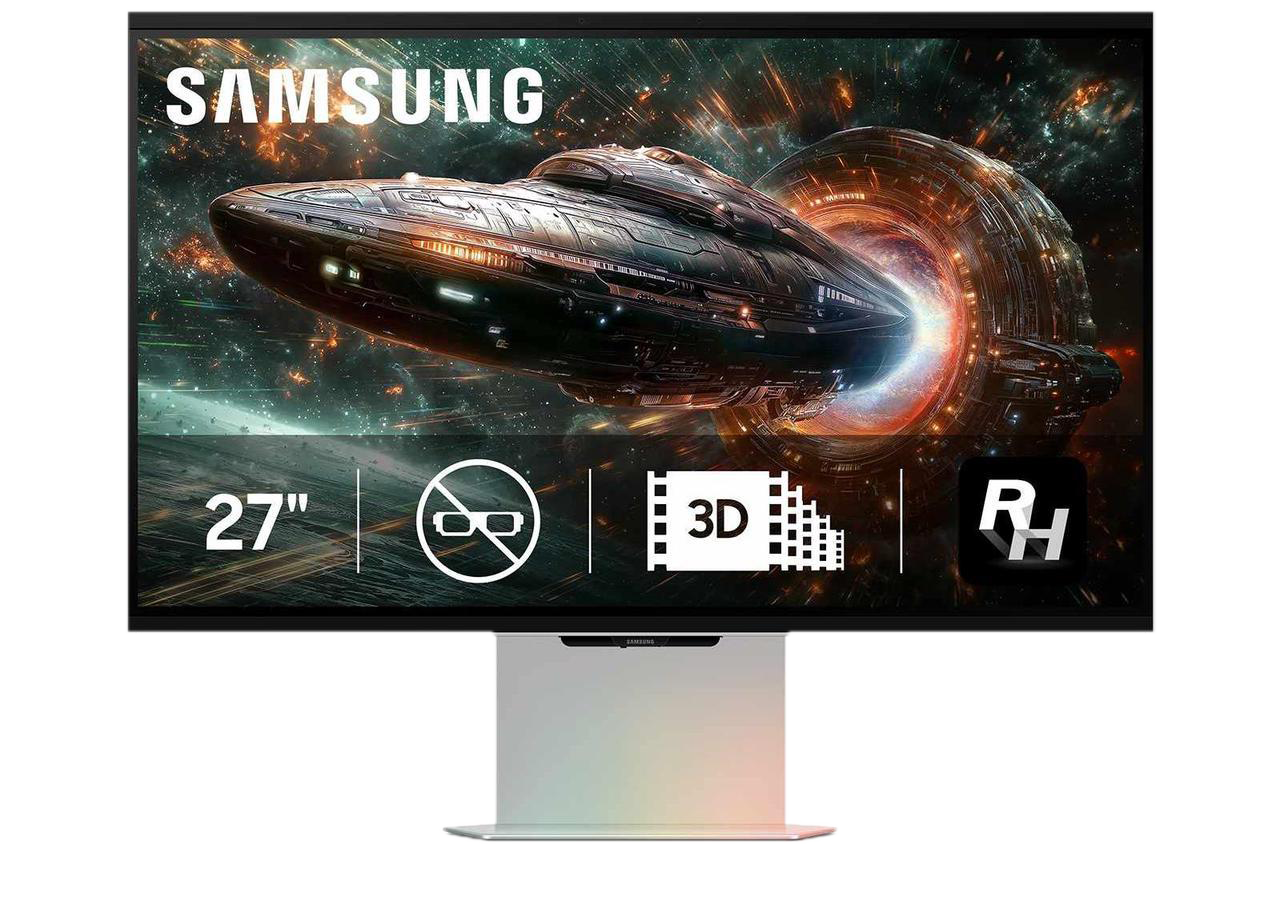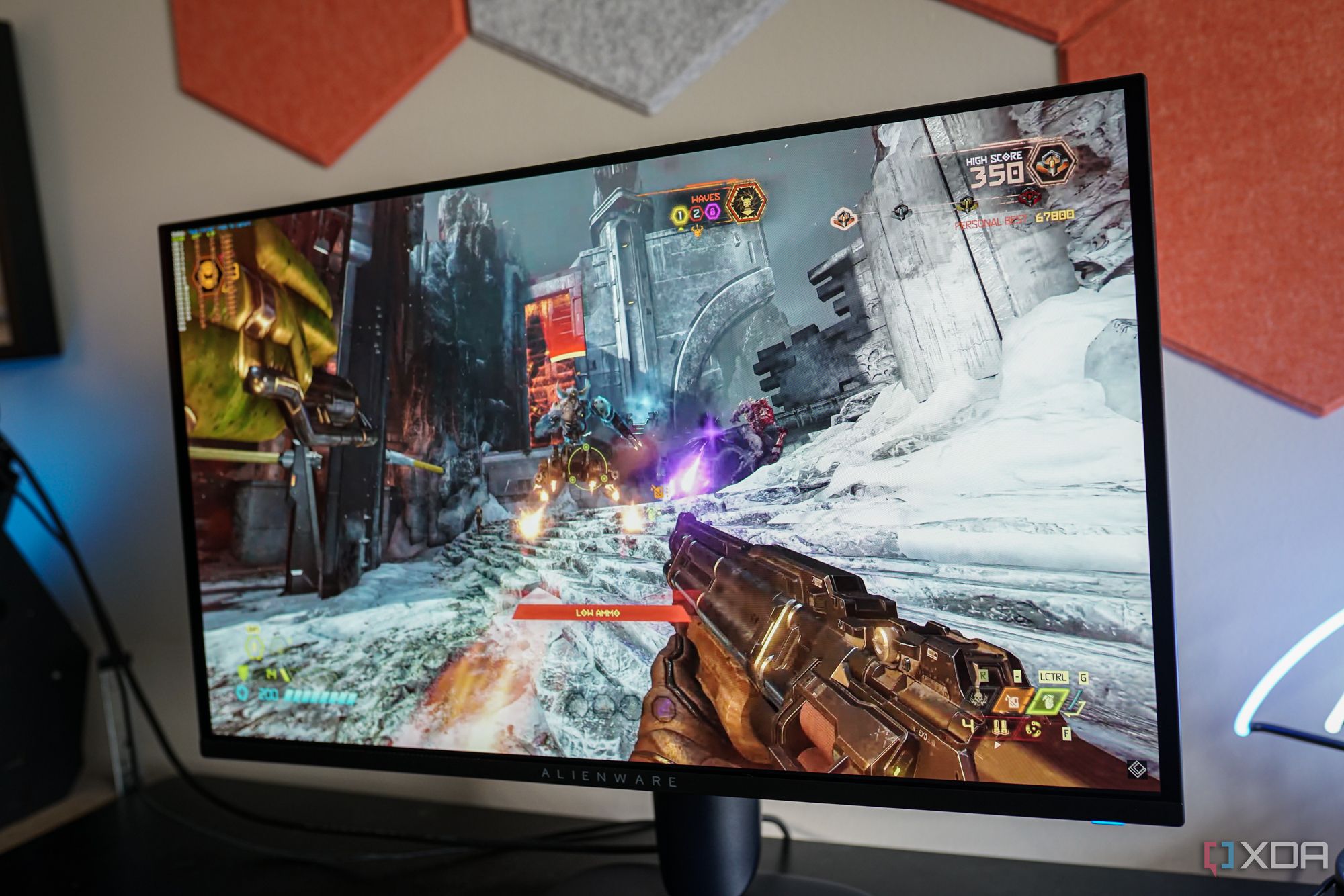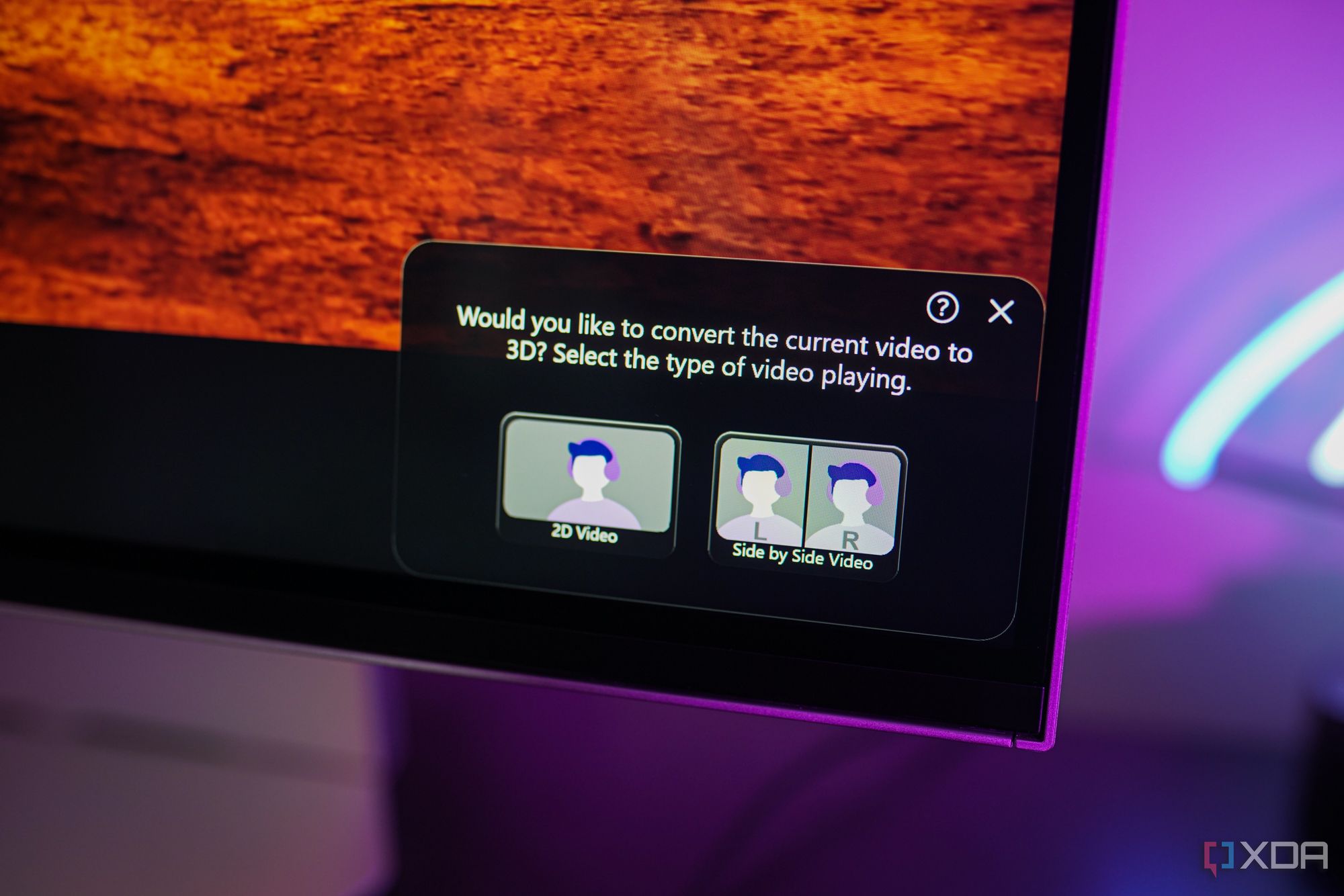There’s one monitor I’ve been looking forward to for the past two years: Samsung’s Odyssey 3D. It started as a prototype as brands like Acer were pushing out SpatialLabs options for ungodly prices. Samsung’s promise was simple. It would provide the glasses-free 3D display technology that had been at the fringes of the best gaming monitors and push it into the mainstream. And yet, even two years on, with the Odyssey 3D finally available for sale, it still feels like a prototype.
This is by far the best version of glasses-free 3D I’ve used. That hasn’t changed. However, limited game support and high requirements for video conversion put a damper on the technology Samsung is delivering. The Odyssey 3D could be an exceptional monitor that provides a gaming experience you can’t get anywhere else. Right now, though, it’s a wonderful tech demo and a downright disappointing gaming monitor for the price.
Samsung sent us the Odyssey 3D for review. It had no input on the contents of this article.

Samsung Odyssey 3D
When the Odyssey 3D is working how it should, it’s a glimpse into the future. It’s just a shame that it rarely works the way it should.
- Extremely immersive with glasses-free 3D
- Automatic video conversion works great (when it works at all)
- Large “sweet spot” for 3D effects
- Glossy finish is horrible for reflections
- Spotty support for 2D video conversion
- Panel quirks including pixel fringing
- Game support is still limited
Samsung Odyssey 3D pricing and availability
There’s no way to slice it: the Odyssey 3D is expensive. It’s $2,000, which is even more expensive than what you can pick the monitor up for in other regions of the world. Even flagship OLED gaming monitors like the MSI MPG 272URX clock in around $1,100, and unique formats like Samsung’s Odyssey Neo G9 can be had for $1,700. The only other thing more expensive is a large-format TV or Samsung’s own Odyssey Ark. You’re spending a hefty premium for the 3D effect alone, which shouldn’t come as a surprise.
Given how expensive the Odyssey 3D is and how niche its applications are, you shouldn’t have any issues finding it in stock. It’s available at the time of writing directly from Samsung, and that probably won’t change. I wouldn’t recommend picking up the monitor right away, though. Samsung is very aggressive with discounting its highest-end monitors, so I wouldn’t be surprised to see $500 (or more) shaved off the price during a promotion a few months down the line.
One of the best-looking gaming monitors I’ve ever seen
Samsung’s design chops shine once again
The Odyssey 3D looks amazing, and it damn well better considering the price. Like all of Samsung’s modern Odyssey lineup, you get a monolithic stand with a silver finish, but the construction is mostly plastic. The minimal stand and silver design means the Odyssey 3D wouldn’t look out of place in an Ikea display. It doesn’t draw too much attention to itself, instead resembling some idealized version of a monitor you’d find somewhere on display. I like that approach personally. It works well for Samsung’s lineup.
Still, Samsung packed in a bit of gamer flair. Under the front lip of the display, you get a string of RGB lighting. In previous designs, such as the Odyssey OLED G8, Samsung offered a bit of diffused light where the stand connects to the monitor, but I like this design much more. You can actually see the light, unlike the faux bias lighting previous Odyssey designs offered. It’s diffused well, too, so the default color spectrum effect blends seamlessly as it runs across your desk.
Samsung includes a cable routing channel through the stand that runs directly into the ports of the display. You get two HDMI 2.1 ports along with a single DisplayPort 1.4 connection. You also get a pair of USB 3.1 Gen 1 ports using a Type-A connection, which you can access by plugging in the included USB-B cable. Although both are accessible, you can only use one of the two ports for firmware updates. Thankfully, it’s marked on the monitor with a “Service” tag.
Controlling the monitor happens with a simple four-way joystick. Samsung has a feature-rich and easy-to-navigate on-screen display (OSD), but I’ve grown accustomed to swapping monitor settings through software. Asus and Sony offer this feature, among others, and I’m disappointed that the Odyssey 3D is locked down to a simple OSD. Samsung has been cramming its smart TV operating system into other Odyssey monitors for the past couple of years, and the Odyssey 3D, given its requirements, would benefit massively from the OS. Unfortuantely, it’s not here.

Related
I didn’t know I needed a monitor light bar until I got one
I never thought it would make such a big difference
A solid IPS panel but not much more
3D is the draw here, not top-notch panel quality
Although glasses-free 3D is the whole reason to go out and buy the Odyssey 3D, the 2D image quality is extremely important. As I’ll dig into in the next section, you’ll be using this as a regular monitor the vast majority of the time, across both regular PC use and playing games. Samsung is using a fairly benign IPS panel that clocks in at 27 inches with a 4K resolution, and it works decently well for games when paired with a 165Hz refresh rate and VRR support. Still, it’s nothing special, and certainly nothing to spend $2,000 on alone.
Samsung delivered on my expectations for a quality IPS panel. Colors are excellent, as you can see in the table below. You’re not getting the color coverage or accuracy that you’ll find with one of the latest QD-OLED panels, such as the one featured on the AW2725Q, but the results are solid for an IPS panel. I tested with the “Original” picture profile here, but there’s quite a bit of leeway to adjust the color between the dozen or so presets Samsung includes.
|
sRGB coverage |
99% |
|---|---|
|
AdobeRGB coverage |
83% |
|
DCI-P3 coverage |
92% |
|
Color accuracy (sRGB) |
1.93 |
Although color accuracy and coverage are decent, this isn’t a monitor for sensitive color work. Frankly, there are many better options around this price, and there are some strange issues with the image quality due to the construction of the 3D panel; more on that in a bit.
Color is decent, but brightness and contrast are a different story. As you can see from the results below, the Odyssey 3D peaked at just below 550 nits in SDR. By the standards of something like an OLED panel, that’s great, but displays like Samsung’s own Odyssey Neo G8 can get much brighter.
|
1% |
316 nits |
|---|---|
|
5% |
443 nits |
|
10% |
545 nits |
|
25% |
537 nits |
|
50% |
525 nits |
|
100% |
501 nits |
|
Static contrast |
1010:1 |
HDR doesn’t change the story. In fact, the Odyssey 3D was just a hair dimmer with HDR turned on, and even turning on dynamic contrast and local dimming didn’t change that story. Contrast peaked at just 1,070:1, even with local dimming on. That’s just a touch over what an IPS panel should be able to achieve. The 3D effect may be a neat party trick, but the raw panel quality here is nothing to get excited about.
My issues with the Odyssey 3D really come down to the subjective elements of the panel, though. For starters, this is a pure gloss finish. It’s extremely reflective, which makes the low peak brightness all the worse if you’re using the display in a brightly-lit room. The glossy finish helps the colors pop, but the trade-off in reflections isn’t worth it. This isn’t a glossy finish with an anti-reflective coating or anything like that; it’s just glossy.
The more pressing issue comes down to the panel’s construction. There’s fringing with the pixels, not dissimilar from the effect you get when you look too closely at the screen on a Nintendo 3DS. The high resolution means you don’t notice the fringing much during use, but static colors on the screen, as well as looking at the display from an angle, shows the odd pixel layout clearly.
Pushing games into the third dimension
At least occasionally
Samsung has shifted its plans for the Odyssey 3D multiple times, so it’s important to get the capabilities of the display straight. The 3D effect only works in a select number of supported games, and you’ll need to launch those games through Samsung’s Reality Hub software, as well as connect the included USB-B cable to your PC. Among those supported games, there are two buckets of support. Some games, such as The First Berserker: Khazan, have a gold star in Reality Hub, meaning Samsung has worked directly with the developer to implement 3D features, and you’ll be able to control them from the game’s menu. Other games are simply compatible with the 3D effect.
There isn’t a quality difference, at least none that I noticed during my testing. However, you need to use shortcuts to turn the 3D on or off in these games, or to increase the intensity of the 3D. Thankfully, you can rebind these commands within Reality Hub, so you shouldn’t have any interference with your controls in games. Samsung says that it will support at least 50 games by the end of the year. For now, here’s the list:
- The First Berserker: Khazan
- Lies of P
- Stray
- Dragonball Z: Kakarot
- Little Nightmare 2
- F.I.S.T.
- SpongeBob SquarePants: The Cosmic Shake
- Wigmund
- Grand Theft Auto Trilogy – The Definitive Edition
- Disney Epic Mickey Rebrushed
- The Smurfs – Dreams
- Palworld
The catalog of games is strange, but there’s probably a reason for that. All the games currently supported, and those with upcoming support like Octopath Traveler, are built using Unreal Engine 4. That covers a lot of games, certainly, but Samsung will need to figure out the limitations of its 3D tech quickly. Acer, who also has glasses-free 3D tech via SpatialLabs, supports well over 100 games, including those built with proprietary engines like God of War. It’s great that Samsung is trying to tackle the issue at an engine level to broaden support quickly. But focusing solely on Unreal Engine 4 isn’t enough.
Still, in the games where 3D works, it works. Samsung uses a lenticular lens on the front panel along with a stereo camera to track the movement of your eyes. In a game like The First Berserker, it locks onto your eyes immediately and holds on for dear life. You have to move uncomfortably far out of view of the display for the 3D effect to break. Moreover, I tested with my curtains open, closed, at night, during the day, and with the lights on and off. And regardless of the context, the 3D worked perfectly.
The gaming experience is great in the few supported titles there are. Movies are a different story. Rather than explicitly support any specific content, Samsung uses automatic 2D-to-3D conversion for movies, which it says is powered by AI. It’s only slightly worse than the native support in games, too. In something like the Oblivion: Remastered trailer, you can see halos around objects in dense cityscapes, giving away the trick that’s going on behind the scenes. But the vibrant color and stark contrast of Furiosa: A Mad Max Saga felt tailor-made for this type of conversion. I was sucked into the movie and completely forgot I was trying to review a monitor.
The problem is how restrictive the conversion is. You can only use it when watching videos in full-screen mode without HDR, and you can’t watch videos from any platform with DRM. So, you won’t get the 3D effect on your Netflix movies or YouTube shows. This is mainly for local video files, and even then you could run into issues. Beyond the limitations on video, you need an extremely specific PC for the effect to work. You need at least an RTX 3080 or RTX 4070, or better, GPU. There isn’t any support for AMD and Intel GPUs whatsoever.
Further, I ran into issues with RTX 50-series GPUs. Even with the RTX 5080, the 2D conversion consistently failed. With the RTX 5060 Ti, I could watch side-by-side 3D video files, but not run the 2D conversion. Samsung needs to make it clear what hardware you need for the Odyssey 3D to work properly, and it hasn’t done a very good job of that at this point. I certainly don’t want to spend $2,000 on a monitor only to find out my brand new RTX 50-series GPU doesn’t work properly with it.
Samsung has a lot to prove if it wants the Odyssey 3D to catch on, and that proof isn’t here now. Gaming on the display is impressive, but the list of supported titles is far too small and niche to make an impact. The idea of automatically converting 2D videos is great, but the lack of support for non-Nvidia systems and list of restrictions means it’s not practical. Samsung is charging a high premium for cutting-edge tech, and I don’t have a problem with that. As it stands now, though, the best case for buying the Odyssey 3D is to play a handful of games at 3D but otherwise use it as a normal, 27-inch monitor. In that use case, it’s just not worth the price.

Related
I’ve reviewed dozens of gaming monitors. Here’s what brands get right (and wrong)
Same panels, but some important differences between major gaming monitor brands.
Should you buy the Samsung Odyssey 3D?
You should buy the Samsung Odyssey 3D if:
- You want to be on the cutting-edge of display technology.
- You’re OK dealing with limited game support initially and temperamental 2D conversion.
- You’re willing to spend up while sacrificing performance.
You should NOT buy the Samsung Odyssey 3D if:
- You play a wide variety of games.
- You want an exceptional HDR experience.
- You have a bright room.
The Odyssey 3D is very impressive, but I can’t recommend it. It’s on the bleeding edge of display technology, and Samsung is charging accordingly. With broader game support and fewer stipulations on the automatic 2D video conversion, the Odyssey 3D could be something special. As it stands now, however, it’s hard to justify the display even as an early adopter.

Samsung Odyssey 3D
The Samsung Odyssey 3D is a 27-inch 4K gaming monitor with a 165Hz refresh rate. With the use of a stereo camera and lenticular lens display, it’s able to deliver glasses-free 3D in videos and supported games.













